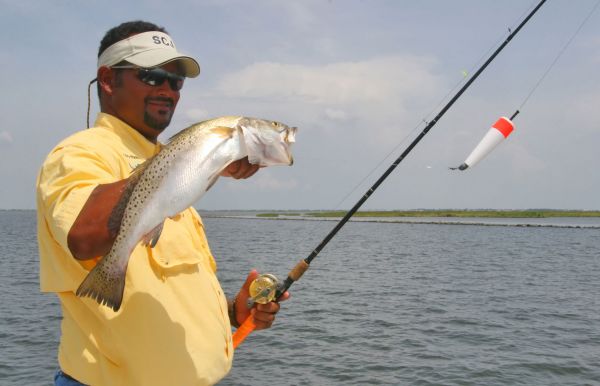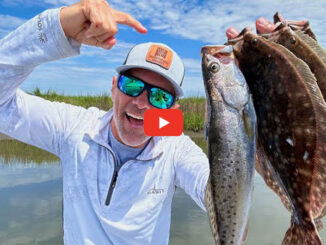Perfect for reaching specks on deep shelves in 10 to 20 feet of water
Capt. Eric Dumas probably wouldn’t go so far as to compare fishing corks with golf clubs – you know, a specialized cork for many different situations – but he does understand that using the right cork at the right time helps him catch more speckled trout.
For Dumas, the right cork is a sliding cork when he finds himself fishing anywhere from 10 to 20 feet with some kind of shelf between those two depths.
“Take a place like the CSX train bridge,” said Dumas, who spends most of his time operating Living A Dream Guide Service out of Lake Pontchartrain. “There’s a spot on that bridge where the bottom drops off from 11 to 20 feet kind of quickly. That’s the perfect kind of spot for fishing a sliding cork.”
The other perfect kind of spot for his sliding cork is on the bridges that span Lake Pontchartrain – namely the Trestles and the Causeway.
If you fish Lake Pontchartrain or you have some kind of deep-water drop off where you fish, Dumas says sliding corks are working right now, and they’ll continue working throughout May and into the summer.
“I just get those little bobber stops with the string and beads,” Dumas said. “I like to use a big float with no weight in it. Then I use a 3/4-ounce egg weight, a swivel, and a regular old 40-pound test leader with a treble hook. Once you get past the cork, it’s really just a suspending Carolina rig.”
One of the major benefits of fishing a sliding cork rather than a Carolina rig is being able to keep a live bait suspended high enough so bottom feeders don’t bother it that much.
“However deep I’m fishing, I set the depth of my cork so my shrimp is a foot or two off the bottom,” said Dumas. “This keeps my shrimp suspended over the heads of croaker and hard-heads. If you’ve ever noticed that trout eat a soft plastic right as it starts dropping to the bottom after you jig it up – I want my shrimp right in that zone.”
Since Dumas fishes Lake Pontchartrain, he focuses mainly on the bridges. Although your situation might be different where you fish, he explained that the best way to fish a sliding cork wouldn’t really be all that different no matter the location.
“I don’t even cast it,” Dumas said. “I just drop it off the side of the boat and let the current take it wherever it wants to go. This makes a sliding cork a good fish locator. Once you figure out how the trout are set up, you can just keep hand feeding it right to that same spot over and over again.”
When the tide is falling out of Lake Pontchartrain, Dumas positions his boat on the west side of a bridge and allows the current to take his sliding cork toward the bridge.
When the tide is coming in, he ties to the bridge and let the current take it away from the bridge.
“The south shore is a little different, though, because the tide will run parallel to the bridge,” Dumas noted. “Then you can just hand feed line to your sliding cork and let it pass by each set of pilings. Once you figure out which set they’re on, you can keep it there by feeding it line and pulling it back… feeding it line and pulling it back.”
Dumas did advise anglers use braided line – he uses Power Pro – for their main line since it floats on the water. Mono sinks, which means it will all be underwater whenever you go to set the hook. The braided line keeps him in direct contact with his cork and allows for certain hook sets.
Louisiana might be full of lots of shallow saltwater flats, but if you have some deeper areas where you fish, tying on a sliding cork will help you catch more trout this month.
Editor’s Note: This is the fourth article in a weeklong series by Chris Ginn on effective speckled trout fishing techniques to try this month. Yesterday he highlighted the popping cork. Tomorrow he’ll wrap up the series with the Carolina rig.



